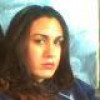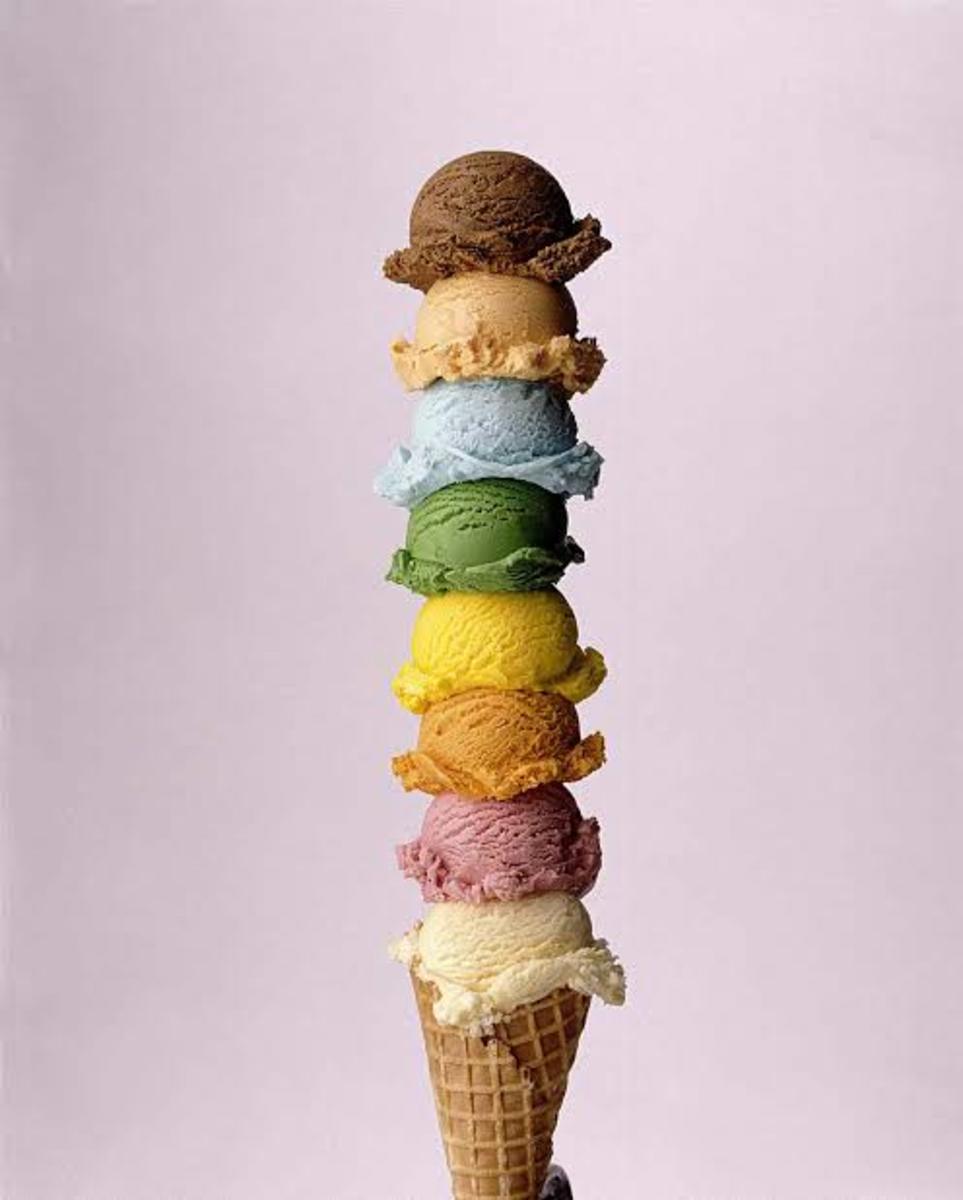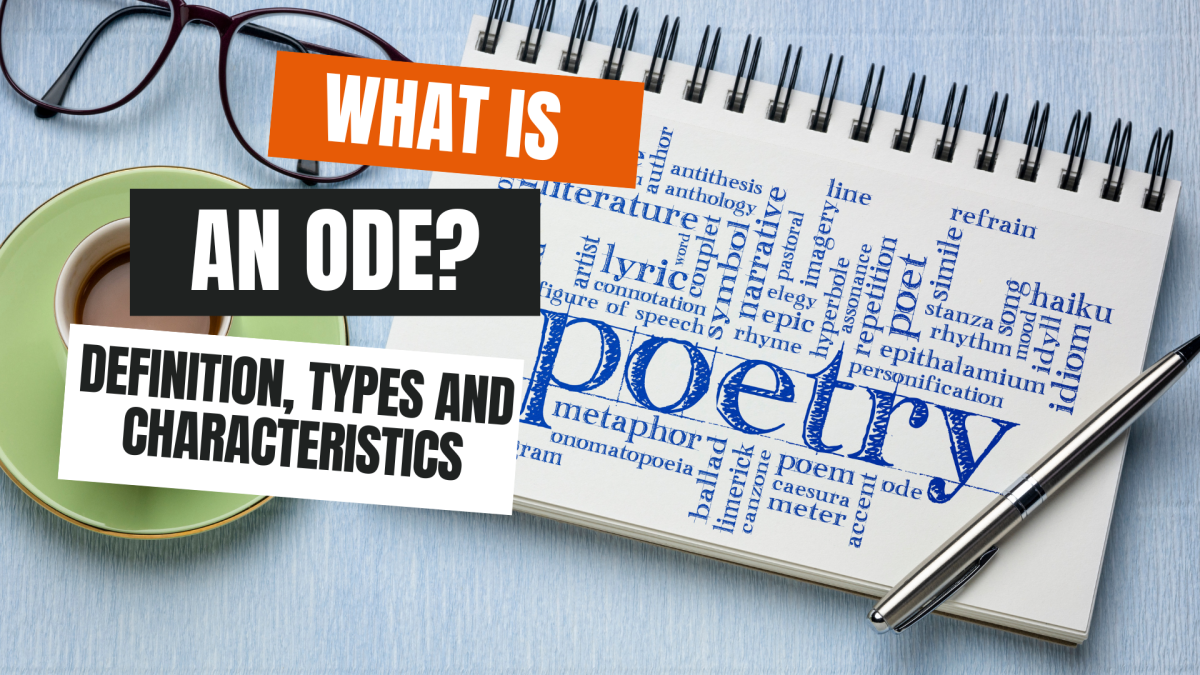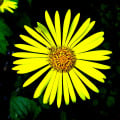The Epic Ballad of Poetry
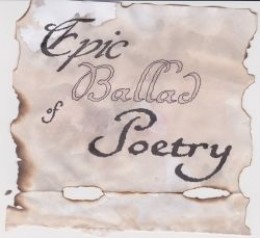
Whether you're a novice or have been writing poetry most of your life,(or even just creative writing) one way or another this page has all kinds of ways to help you out. I wrote it in the hopes to make a COMPLETE study & writing guide.
In this Lens you will Find out Poetic writing terms, Forms, Devices, everything from Vocabulary to Types of poem styles & parts, as well as what rules if any apply to them (like for a Diamante has to be in shape of a diamond, Sonnets, & Haikus).
I also have information for entering Contests & information on judging (at least for one), self publishing & how to publish your own E-book as well as links to helpful pages from a writing blog.
I've included videos that seemed interesting if you will be interested to learn how to write poetry, even an award winning one in 5 minutes! Get over writer's Block, various links for additional information, as well as books on famous poets, links to help you learn as well and a couple sections throughout for 'supplies' like if you are just starting or just need a new journal, writing instruments and so on. There is a link to the 'Creative writing' page that used to be a part of this page.
(but being as it was long and too long, I split them into their own entities)
Want to know when I add something?
April is National Poetry month
The Epic Ballad of Poetry by Kim Marie Ostrowski is licensed under a Creative Commons Attribution-NonCommercial-NoDerivs 3.0 Unported License.
Alternate words for Poem or poetry
I looked up other words to use in a thesaurus other than poem or poetry but what's listed are TYPES of poems or PART of a poem
VERSE is a paragraph of a poem
a LYRIC is really part of a song,
an ODE is a tribute to something,
a SONG is different from a poem,
a SONNET is a type of poem with certain amount of lines etc.
RHYME is also listed but It's more than a rhyme. A 'rhyme' is a single sentence or 2 words that do.
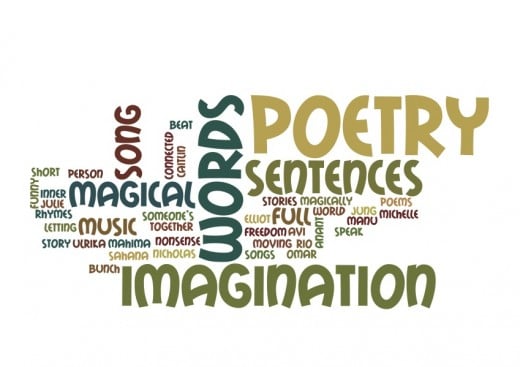
What Is Poetry?
The American Century Dictionary defines it as art or work of a poet, poetic or tenderly pleasing quality. While Poem is defined as a metrical composition concerned with feeling or imaginative description
When one speaks of 'Poetic License' they talk of the artist's (here being the writer or poet) disregard for conventional rules for effect. It isn't always about words that Rhyme together, it is the use of words in a remarkable way; that does not adhere to the usual confined rules of writing. You don't have to use punctuation, (though it helps if you want the reader to read it in the correctly in the right rhythm). You can make up your own words, or use a word in a totally different way that one would.
Poetry is self expression, a form of art. Some of us may not have the talent to draw, however when we weave our words we can paint that picture for the reader to see in their heads & feel our emotion.
Ancient People believed that because Poets otherwise known as 'Bards' or 'balladeers' could build a thought or story in an interesting way, and they had more power than ordinary people.
Some religious texts might be written in Rhythmic (Rith-mick) verse. These words seemed inspired by higher powers.
Wiki notes & I Quote
"Poetry (from the Greek 'poiesis') a making: a forming, creating, or the art of poetry, or a poem) is a form of literary art in which language is used for it's aesthetic and evocative qualities in addition to, or in lieu of, its apparent meaning. Poetry may be written independently as discrete poems, or may occur in conjunction with other arts, as in poetic drama, hymns, lyrics, or prose poetry. It is published in dedicated magazines (the longest established being Poetry and Oxford Poetry), individual collections and wider anthologies."
Below you will find Vocabulary, "Terms & Types" of Poetry, how to write it, self Publishing, when you are done, and many other manner of subject in the artistic writing prose and Rhyme.
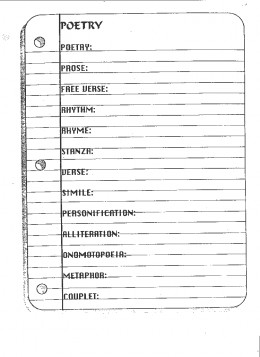
Dramatic Dialog A-E
Types & Terms of Poetry
Accent- The prominence or emphasis given to a syllable or word; In the word poetry, the accent (or stress) falls on the first syllable.
Acrostic- An Acrostic Poem has a topic idea running vertically down the side of the poem, it's fun for Kids as well as adults to write. For Instance with Pumpkins, Each letter in the topic word has a new thought that runs off it from left to right and is relevant to the topic word, which is typically the title as well, for a few examples: P- would be Pie M= mashed & S- SEEDS
Alexandrine - A line of poetry that has 12 syllables. The name probably comes from a medieval romance about Alexander the Great that was written in 12-syllable lines.
ALLEGORY - Allegory is a form of extended metaphor. An allegory is a story with two meanings, a literal meaning and a symbolic meaning.
Alliteration- The repetition of the same or similar sounds at the beginning of words: "What would the world be, once bereft/Of wet and wildness?" (Gerard Manley Hopkins, "Inversnaid") also see Rhymes & Section Epic & Dramatic form
Alvissmal- (Norse) Skaldic synonyms
anapest -A metrical foot of three syllables, two short (or unstressed) followed by one long (or stressed), as in seventeen and to the moon. The anapest is the reverse of the dactyl.
antithesis- A figure of speech in which words and phrases with opposite meanings are balanced against each other. An example of antithesis is "To err is human, to forgive, divine." (Alexander Pope)
apostrophe - Words that are spoken to a person who is absent or imaginary, or to an object or abstract idea. The poem God's World by Edna St. Vincent Millay begins with an apostrophe: "O World, I cannot hold thee close enough! Thy winds, thy wide grey skies!/Thy mists that roll and rise!"
April- National Poetry Month
Assonance - is a vowel sound repeated within a line, for instance...How now brown Cow.
BALLAD- A ballad is a poem usually set to music; thus, it often is a story told in a song. Any myth form may be told as a ballad, such as historical accounts or fairy tales in verse form. It usually has foreshortened, alternating four-stress lines ("ballad meter") and simple repeating rhymes, often with a refrain. If it is based on a political or religious theme, a ballad may be a HYMN. It should not be confused with the ballade, a 14th and 15th century French verse form.
Also in Music form, In the 20th Century, "ballad" took on the meaning of a popular song "especially of a romantic or sentimental nature" (American Heritage Dictionary). Casting directors often divide songs into two categories: "ballads" (slower or sentimental songs) and "up" tunes (faster or happier songs). A power ballad is a love song delivered with power often using rock instruments. The 80s & 90s 'Hair' bands were popular for this.
BALLADE - A 14th & 15th century FRENCH verse form. This type of poem usually hasthree stanzas of seven, eight, or ten lines; and a shorter final stanza (or envoy) of four or five lines. All stanzas end with the same one-line refrain (see Links for how to write & examples of)
Bucolics (also called the Eclogues) is the first of the three major works of the Latin poet Virgil
Blank Verse -. Poetry that is written in unrhymed iambic pentameter, Shakespeare wrote most of his plays in blank verse.
caesura - A natural pause or break in a line of poetry, usually near the middle of the line. There is a caesura right after the question mark in the first line of this sonnet by Elizabeth Barrett Browning: "How do I love thee? Let me count the ways."
Calligram - See Epic & Dramatic Form "Visual Poetry"
Canzone- Medieval Italian form with strong similarities to the sestina. There are no rhymes; instead there are five keywords that determine the structure of the poem. Every line of the poem - and there are 65 lines altogether - ends with one of the keywords, which must appear in a prescribed order. with five or six stanzas and a shorter concluding stanza (or envoy). The poets Petrarch and Dante Alighieri were masters of the canzone.
Cinquain - 1. a short poem consisting of five, usually unrhymed lines containing, respectively, two, four, six, eight, and two syllables. 2. any stanza of five lines (dictionary.com)
chanson de geste- An epic poem of the 11th to the 14th century, written in Old French, which details the exploits of a historical or legendary figure, especially Charlemagne.
Clerihew-a funny poem you write about a specific person. They're 4 lines long, the first line names the person and the second line ends with something that Rhymes with the person's name. These first two lines are supposed to Rhyme with each other see this page for examples Poetry Class Lessons
conceit- A fanciful poetic image or metaphor that likens one thing to something else that is seemingly very different. An example of a conceit can be found in Shakespeare's sonnet "Shall I compare thee to a summer's day?" and in Emily Dickinson's poem "There is no frigate like a book."
Concrete Poems- These are fun to read, & write. The author may arrange and space the words and letters to form a picture pattern of what the poem is about. Say if its about a mouse, you shape it like a full mouse or minimally as the tail. (see my poems for picture example of 'Life is a Hill)
Consonance- The repetition of similar consonant sounds, especially at the ends of words, as in lost and past or confess and dismiss & pitter patter
Couplets- a pair of lines that are the same length and usually rhyme and form a complete thought. Shakespearean sonnets usually end in a couplet.
Heroic Couplet: Two lines of rhyming iambic pentameter. Most of Alexander Pope's verse is written in heroic couplets. In fact, it is the most favored verse form of the eighteenth century. Example:
u / u / u / u / u /
'Tis hard to say, if greater want of skill
u / u / u / u / u /
Appear in writing or in judging ill. . . .
--Alexander Pope
again see glossary of literary terms
Dada Poem- Hobby horse in French a word selected at random from the dictionary that you create a poem about
Dactyls -a foot of three syllables, one long (or Stressed) followed by two short (or unstressed) in quantitative meter,(Happily) or one stressed followed by two unstressed in accentual meter, as in gently and humanly The dactyl is the reverse of the anapest.
Dactylic Hexameter- Hexameter
Diamante-A diamante is a seven line poem, shaped like a diamond (see links below 'diamond')
Didactic- meant to instruct, insists to adhering to formal rules or literal meaning
Dramatic Monologue- a type of poem, favored by many poets in the Victorian
period, in which a character in fiction or in history delivers a speech
Dramatic Dialog- an exchange of ideas or opinions on a particular issue, esp. a political or religious issue, with a view to reaching an amicable agreement or settlement.
Eclogue- a classical style on a pastoral subject. Poems in the genre are sometimes also called bucolic.. The etymology of the word is a Romanization of the Greek eklog meaning 'draft, choice, and selection (particularly of short passages)'. The term originally referred to short poems of any genre, or selections from poetry-books.
Ekphrastic Poetry- based on visual arts. Looking at an object & writing a poem about it/what you see.
Elegy-A poem that laments the death of a person, or one that is simply sad and thoughtful; An example of this type is Thomas Gray's "Elegy Written in a Country Churchyard
originally used for a type of poetic meter (Elegiac meter), but is also used for a poem of mourning, from the Greek elegos, a reflection on the death of someone or on a sorrow generally - which is a form of lyric poetry. An elegy can also reflect on something which seems strange or mysterious to the author. & NOT TO BE CONFUSED w/ Eulogy
Ekphrastic Poetry- based on visual arts. Looking at an object & writing a poem about it/what you see.
Epic - An extended narrative poem recounting actions, travels, adventures, and heroic episodes and written in a high style. (Please see for more info)Two of the most famous epic poems are the Iliad and the Odyssey by Homer, which tell about the Trojan War and the adventures of Odysseus on his voyage home after the war.
Enjambment -The continuation of a complete idea (a sentence or clause) from one line or couplet of a poem to the next line or couplet without a pause. An example of enjambment can be found in the first line of Joyce Kilmer's poem Trees: "I think that I shall never see/A poem as lovely as a tree."
Enjambment -The continuation of a complete idea (a sentence or clause) from one line or couplet of a poem to the next line or couplet without a pause. An example of enjambment can be found in the first line of Joyce Kilmer's poem Trees: "I think that I shall never see/A poem as lovely as a tree." Enjambment comes from the French word for "to straddle."
Envoy -The shorter final stanza of a poem, as in a ballade.
Epigram -a short 2 line poem, sometimes A very short, witty one: "Sir, I admit your general rule,/That every poet is a fool,/But you yourself may serve to show it,/That every fool is not a poet." (Samuel Taylor Coleridge)
epithalamium (or epithalamion) A poem in honor of a bride and bridegroom
Acrostic Poem worksheet
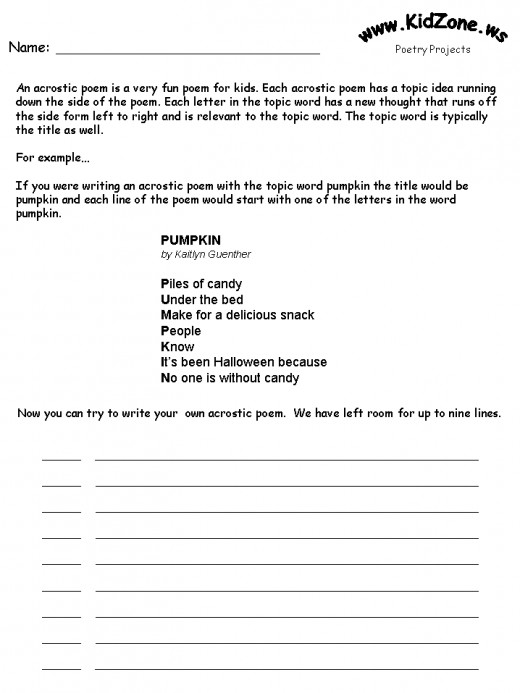
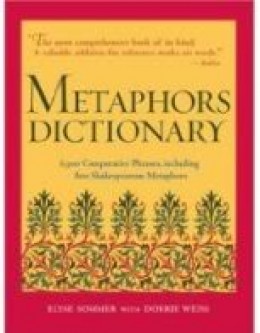
Dramatic Dialog F- Q
Feminine rhyme- A rhyme that occurs in a final unstressed syllable: pleasure/leisure, longing/yearning.
Figure of speech - A verbal expression in which words or sounds are arranged in a particular way to achieve a particular effect. Figures of speech are organized into different categories, such as alliteration, assonance, metaphor, metonymy, onomatopoeia, simile, and synecdoche.
Foot -Two or more syllables that together make up the smallest unit of rhythm in a poem. For example, an iamb is a foot that has two syllables, one unstressed followed by one stressed. An anapest has three syllables, two unstressed followed by one stressed.
Free Verse-(also vers libre) term loosely used for rhymed or unrhymed verse that has no set meter made free of conventional and traditional limitations and restrictions in regard to metrical structure. (Definition from Columbia Encyclopedia) Free Verse does not have to rhyme, or have a pattern.
Genomic poetry- a form of poetry consisting of a meaningful saying that is to aid in memorizing when put into verse
Haiku- A Japanese lyric verse form having three unrhymed lines of five, seven, and five syllables, (or 7, 5, 7) traditionally invoking an aspect of nature or the seasons with simple observations about the world around us.
Heptameter -A line of poetry that has seven metrical feet.
Hexameter -A line of poetry that has six metrical feet.
Hexameter verse - A line of poetry consisting of six measures, the fifth being a dactyl and the sixth either a spondee or a trochee. The other four may be either dactyls or spondees.
Humorous Poems- I'm sure you know they don't have to be serious or always about love. Sometimes the poet is in a funny mood and will write up some funny rhymes even using funny sounding or words they made up & on possibly odd subjects
Hymn- type of song, usually religious, specifically written for the purpose of praise, devotion, adoration or prayer, and typically addressed to a deity/deities, a prominent figure or an epic tale. The word hymn derives from Greek hymnos "a song of praise".
Hyndlvljoth (Norse) - Historical, Gynecological poem.
Hyperbole -A figure of speech in which deliberate exaggeration is used for emphasis. Many everyday expressions are examples of hyperbole: tons of money, waiting for ages, a flood of tears, etc. Hyperbole is the opposite of litotes.
Iamb- A metrical foot of two syllables, one short (or unstressed) and one long (or stressed). There are four iambs in the line "Come live/ with me/ and be/ my love," from a poem by Christopher Marlowe. (The stressed syllables are in bold.) The iamb is the reverse of the trochee.
Iambic pentameter- A type of meter in poetry, in which there are five iambs to a line. (The prefix penta- means "five," as in pentagon, a geometrical figure with five sides. Meter refers to rhythmic units. In a line of iambic pentameter, there are five rhythmic units that are iambs.) Shakespeare's plays were written mostly in iambic pentameter, which is the most common type of meter in English poetry. An example of an iambic pentameter line from Shakespeare's Romeo and Juliet is "But soft!/ What light/ through yon/der win/dow breaks?" Another, from Richard III, is "A horse!/ A horse!/ My king/dom for/ a horse!" (The stressed syllables are in bold.)
Idyll, or idyl -Either a short poem depicting a peaceful, idealized country scene, or a long poem that tells a story about heroic deeds or extraordinary events set in the distant past. Idylls of the King, by Alfred Lord Tennyson, are about King Arthur and the Knights of the Round Table.
Kenning (Poetic) as in Tyr is called "Leaving of the Wolf' a Keening for Glory a>
lay - A long narrative poem, especially one that was sung by medieval minstrels called trouvères. The Lais of Marie de France are lays.
Limerick- light Nonsensical, humorous verse, short,& sometimes ribald. They are Usually Funny or silly and always having five (5) Lines anapestic lines with the rhyme scheme of aabba. If you write one of your own, think of each poem as a VERY short story.
Litotes- A figure of speech in which a positive is stated by negating its opposite.. Some examples of litotes: no small victory, not a bad idea, not unhappy. Litotes is the opposite of hyperbole.
Lyric- having the form and musical quality of a song, and esp. the character of a song like out pouring of the poet's own thoughts and feelings, as distinguished from epic and dramatic poetry. A lyric poem may resemble a song in form or style.
2. Pertaining to or writing lyric poetry: a lyric - ist.
Masculine rhyme -A rhyme that occurs in a final stressed syllable: cat/hat, desire/fire, observe/deserve.
Metaphysical Poetry- highly intellectual and often abstruse imagery involved
Meter- The rhythmic pattern arrangement by the number of syllables & Rhythmic (accented) syllables produced when words are arranged so that their stressed and unstressed syllables fall into a more or less regular sequence, resulting in repeated patterns of accent (called feet)
metonymy -A figure of speech in which one word is substituted for another with which it is closely associated. For example, in the expression The pen is mightier than the sword, the word pen is used for "the written word," and sword is used for "military power."
Mnemonic Poems- 'memory Bank' Poems often little more than Names & Events; Common to 'Oral' Cultures
Metaphor - figure of speech in which two things are compared, usually by saying one thing is another, or by substituting a more descriptive word for the more common or usual word that would be expected. Some examples of metaphors: the world's a stage, he was a lion in battle, drowning in debt, and a sea of troubles. also Here's a separate Squidoo page on Metaphors
Narrative Poems - this type TELLS A STORY. This is longer than most forms of Poetry and can rhyme but doesn’t have to; they can also have patterns that create a rhythm. You can (but don't have to) make each line the same amount of syllables &/or the stanzas have the same amount of Lines (see stanza) Ballads, epics, and lays are different kinds of narrative poems.
Octave- interval between and includes two notes one in which has twice or half the frequency or vibration of the other. Eight notes occupying an interval
Ode- a lyric poem typically of elaborate or irregular metrical form and expressive of exalted or enthusiastic emotion (originally intended to be sung). Serious and thoughtful in tone it has a very precise, formal structure. Or it can be better defined as a tribute about or to a subject (most commonly a person or something in nature sometimes some other subject that you like or love)
onomatopoeia- A figure of speech in which words are used to imitate sounds. Examples of onomatopoeic words are buzz, hiss, zing, clippety-clop, and tick-tock. Keats's "Ode to a Nightingale" not only uses onomatopoeia, but calls our attention to it: "Forlorn! The very word is like a bell/To toll me back from thee to my sole self!" Another example of onomatopoeia is found in this line from Tennyson's Come Down, O Maid: "The moan of doves in immemorial elms,/And murmuring of innumerable bees." The repeated "m/n" sounds reinforce the idea of "murmuring" by imitating the hum of insects on a warm summer day (please also see Epic & Dramatic form section)
ottava rima-A type of poetry consisting of 10- or 11-syllable lines arranged in 8-line "octaves" with the rhyme scheme abababcc.
Pentameter- a line of five metrical feet.
Pantoum- consisting of an indefinite number of quatrains with the second and fourth lines of each quatrain repeated as the first and third lines of the following one
pastoral- A poem that depicts rural life in a peaceful, idealized way. portraying or suggesting idyllically the life of shepherds or of the country, as a work of literature, art, or music: pastoral poetry; a pastoral symphony
personification- A figure of speech in which things or abstract ideas are given human attributes: dead leaves dance in the wind, blind justice. (also see Epic & Dramatic form section)
Prose- some may write a story using Prose form which is language written or spoken in an ordinary way. The story is the MOST IMPORATANT THING, but when the author uses poetry the way the words read or sound is part of the goal along with the story.
Quatrain- A stanza or poem of four lines
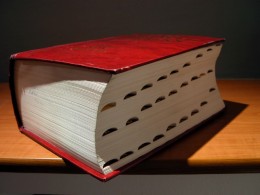
Dramatic Dialog R- Z
Types & Terms of Poetry
Refrain- A line or group of lines that is repeated throughout a poem, usually after every stanza
Rhyme- Most think of a poem as Rhyming, which is not true, for instance one type of poem called haikus do not rhyme; but there is also different kinds of Rhyming.
Another is The occurrence of the same or similar sounds at the end of two or more words.
When the rhyme occurs in a final stressed syllable, it is said to be masculine: cat/hat, desire/fire, observe/deserve.
When the rhyme occurs in a final unstressed syllable, it is said to be feminine: longing/yearning. The pattern of rhyme in a stanza or poem is shown usually by using a different letter for each final sound. In a poem with an aabba rhyme scheme, the first, second and fifth lines end in one sound, and the third and fourth lines end in another.
Perfect Rhyme - as in Moon & June
Sight Rhyme- like Though & Bough They don't rhyme when we say them but look the same on the page.
Slant Rhymes - in which the last consonant is the same like Whip & top
Head Rhymes- in which the beginnings of stressed words sound the same like Pretty as a picture. This is also called Alliteration
rhyme royal- A type of poetry consisting of stanzas of seven lines in iambic pentameter with the rhyme scheme ababbcc. Rhyme royal was an innovation introduced by Geoffrey Chaucer.
Romanticism- The principles and ideals of the Romantic Movement in literature and the arts, during the late 18th and early 19th centuries. Romanticism, which was a reaction to the classicism of the early 18th century, favored feeling over reason and placed great emphasis on the subjective, or personal, experience of the individual. Nature was also a major theme. The great English Romantic poets include Wordsworth, Coleridge, Byron, Shelley, and Keats.
Rondeau- Pros.a short poem of fixed form, consisting of 13 or 10 lines on two rhymes and having the opening words or phrase used in two places as an unrhymed refrain.
Rondelet-modified rondeau consisting usually of seven lines in which the first line of four syllables is repeated as the third line and as the final line or refrain and the remaining lines are made up of eight syllables each
Roundel-an English modified rondeau
Satire- literary work holding up human vices and follies to ridicule or scorn trenchant wit, irony, or sarcasm used to expose and discredit vice or folly
Sestina- less commonly, though more correctly, sextain) is a wondrous strange beast, the brainchild of a twelfth-century Provencal troubadour. It doesn't use rhyme; instead, it has six keywords essential to the poem's structure. The poem's 39 lines - six 6-line stanzas followed by a 3-line envoi or tornada - all end with one of the keywords; in the tornada, there are two keywords in each line, one of them at the end and the other somewhere in the middle. It may all begin to make sense if we try an example.
Scansion- The analysis of a poem's meter, this is usually done by marking the stressed and unstressed syllables in each line and then, based on the pattern of the stresses, dividing the line into feet.
senryu- A short Japanese poem that is similar to a haiku in structure but treats human beings rather than nature, often in a humorous or satiric way.
Simile -A figure of speech in which two things are compared using the word "like" or "as." An example of a simile using like occurs in Langston Hughes's poem "Harlem": "What happens to a dream deferred?/ Does it dry up/ like a raisin in the sun?"
Sonnet- A lyrical poem that is 14 lines long; Italian (or Petrarchan) sonnets are divided into two quatrains and a six-line, sestet," with the rhyme scheme abba abba cdecde (or cdcdcd). English (or Shakespearean) sonnets are composed of three quatrains and a final couplet, with a rhyme scheme of abab cdcd efef gg. English sonnets are written generally in iambic pentameter with a varied rhyme scheme.
The two main types of sonnet are the Petrarchan (or Italian) and the Shakespearean. The Petrarchan Sonnet is divided into two main sections (qatraines) , the octave (first eight lines) and the sestet (last six lines). (See Glossary of Literary terms)
Sound Poetry- uses noises that sound interesting together but may not mean anything
spondee-a foot of two syllables, both of which are long in quantitative meter or stressed in accentual meter
stanza- Two or more lines of poetry that together form one of the divisions of a poem. The stanzas of a poem are usually of the same length and follow the same pattern of meter and rhyme.
means "stopping place" in Italian. A stanza is a set of lines in a poem, set apart from other sets of lines by space. Each stanza comprises its own unit. The break/space between stanzas generally indicates a pause between thoughts, concepts or actions. In standard practice, most poems end a sentence at the end of stanza. It is important to remember, however, that there is no definitive rule that says this must happen. Of all writing forms, poetry is the most experimental. Rules of form get broken all the time.
Stress - The prominence or emphasis given to particular syllables. Stressed syllables usually stand out because they have long, rather than short, vowels, or because they have a different pitch or are louder than other syllables.
Synecdoche - A figure of speech in which a part is used to designate the whole or the whole is used to designate a part. For example, the phrase "all hands on deck" means "all men on deck," not just their hands. The reverse situation, in which the whole is used for a part, occurs in the sentence "The U.S. beat Russia in the final game," where the U.S. and Russia stand for "the U.S. team" and "the Russian team," respectively.
Tanka- see haiku
Tercet- a unit or group of three lines of verse:
a: one of the 3-line stanzas in terza rima
b: one of the two groups of three lines forming the sestet in an Italian sonnet
tetrameter - A line of poetry that has four metrical feet.
Treatment- usually used in the movie business as a description of the movies story line & plot twists and such but can be used as in writing to a publisher as well instead of sending a full manuscript.
Triolet-poem or stanza of eight lines in which the first line is repeated as the fourth and seventh and the second line as the eighth with a rhyme scheme of ABaAabAB
trochee-A metrical foot of two syllables, one long (or stressed) and one short (or unstressed). An easy way to remember the trochee is to memorize the first line of a lighthearted poem by Samuel Taylor Coleridge, which demonstrates the use of various kinds of metrical feet: "Trochee/ trips from/ long to/ short." (The stressed syllables are in bold.) The trochee is the reverse of the iamb.
Trope - A figure of speech, such as metaphor or metonymy, in which words are not used in their literal (or actual) sense but in a figurative (or imaginative) sense.
Verse - A single metrical line of poetry, or poetry in general (as opposed to prose). "Paragraph' In poem or song
Villanelle-French verse form running on two rhymes and consisting typically of five tercets and a quatrain in which the first and third lines of the opening tercet recur alternately at the end of the other tercets and together as the last two lines of the quatrain. for more see the 'Poetic' section for the lens on how to write one.
VERSONIFICATION- Generally, the structural form of a verse, as revealed by scansion. Identification of verse structure includes the name of the metrical type and the name designating number of feet:
Monometer: 1 foot
Dimeter: 2 feet
Trimeter: 3 feet
Tetrameter: 4 feet
Pentameter: 5 feet
Hexameter: 6 feet
Heptameter: 7 feet
Octameter: 8 feet
Nonameter: 9 feet
Learn about poetry - books on writing, Learning Poetry & book repair
This section is for books to learn more about poetry, (as well as other creative writing.)
Various learning stages from Children to Adult, I have also included a book on Book Repair as with use, and even with not so much even just heat & the humidity may make the binding come apart, or pages fall out.
Please also see "Creative writing (NON-poetic)" at the bottom of the page for other helpful books
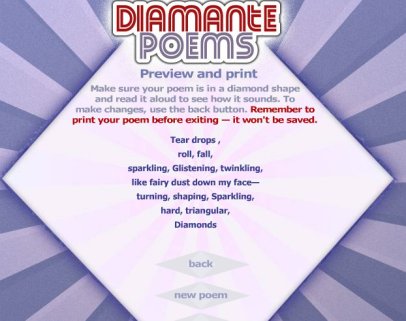
In Epic & Dramatic Form 'Cliffnotes"
Poetic Devices & Forms (types & styles)
Meter- Rhythm
1. Spondee (spondaic) Day breaks
2. Trochee (trochaic) David; Susan
3. Iamb (Iambic) I went to school today (The most common verse in English poetry is iambic pentameter)
4. Dactyl (dactylic) Juliet Capulet
5. Anapest (anapestic) On the front of her gown is a star
Metaphor-comparing one thing to another unlike thing by saying the one is the other; ie: she is my rock
Simile- just the same as metaphor, except that the example is weakened by using like or as ex: She is like my rock
Imagery- words create impressions other than those associated with sight ie: White Silence
Alliteration- use of words with similar beginning sounds ie: Sam sold silk in the cellar
Onomatopoeia- a word that sounds like what it means ie: buzz
Rhyme- the same sound at the end of a word ie: time, sublime
eye Rhyme- words that look like that should rhyme, but don't ie: bought though
Personification-giving human qualities to inanimate objects ie: The clouds cried for joy
Types of Poems
Haiku - a form of Japanese poetry where you use 17 syllables in 3 'Phrases' (Verses) of 5, 7, 5. They usually contain some sort of seasonal Reference. They are traditionally printed in a single vertical line and take subject from the natural world as their inspiration. Though in English, it parallels to 3 lines & use any subject matter
"Diamante' - a poem in the shape of a diamond A Diamante follows a 1,2,3,4,5,4,3,2,1 pattern meaning one word on the first line 2 words on the second and so on. The first & last line should be the same word.
There are 2 kinds of this type of poem Synonym & Antonym (see links below for an example)
Here's a link you can practice http://www.readwritethink.org/files/resources/inte...
Visual Poetry- The visual type is meant to be seen. a poem about the ocean might be written in the shape of waves, This is called a Calligram
Types of Poetic Styles
Allegory
»Ballad
»Ballade
»Black Verse
»Canzone
»Cinquain
»Couplets
»Diamante
»Dramatic Monologue
»Dramatic Dialogue
»Eclogue
»Elegy
»Epic
»Free Verse
»Haiku
»Hymn
»Limerick
»Lyric
»Narrative
»Ode
»Pantoum
»Pastoral
»Rondeau
»Rondelets
»Roundel
»Satire
»Sestina
»Sonnet
»Tanka
»Triolet
»Villanelle
Keys to writing a poem
symbolism
imagery
emotion '(dramatic dialog)
Style
Rhythm
tone
Tempo
Feeling &
Phrasing
What you think you WRITE (Read?) the Most
IF the option is not on Here then by all means PLEASE post it in a comment
What is your Poetry Style?
Poets
from Poe to 'WHO?!' YOU???
Here's a list of poets that I will either include a mini bio, or a listing of some of their poems
Celakovsky, Frantiuek (frän'tuDshuk chu'läkôfskuD), 1799-1852, Czech folklorist and poet
Szymborska, Wislawa Polish poet she was born in 1923 in Bnin a small town near Krakow
Jóhannes úr Kötlum Islandic Author
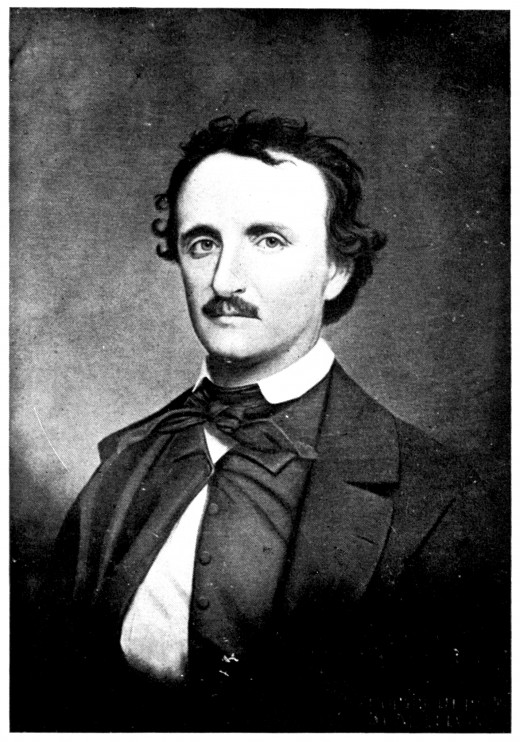
October 7, Remembering Edgar Allan Poe
Slightly more than 200 years ago, a child was born that would become one of the greatest and most influential writers known in this time. Edgar Allan Poes st...
- famous for 'The Raven' & The Telltale Heart.
Robinson Jeffers Wiki- Ghost,* Inscription for a Grey Stone
William Butler , Yeats
Lord George Gordon Byron
John Keats
Shel Silverstein - The Giving Tree, The Missing Piece & One Inch Tall
Walt Whitman - Leaves of Grass (recommended to me)
Leaves of Grass Leaves of Grass Full Published
Alternate words for POET
Bard, lyrisist, or versifier
Works of Great Poets - or just some cool new ones
Here is a listing of the works of our favorite bards. If I have missed mentioning Yours above, or by including their works here then please let me know or add it to the list.
Ellen Hopkins is a Poetic writer by that I mean her stories are written in rhyme or a form of poetic prose. check out the book below *look inside & you'll see what I mean.
Look for Poet Laureate Natasha Trathewey
Who's your Favorite bard
Your favorite Poet
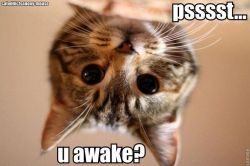
Cats
by B. J. Poskitt
Lazy cats and wanderer
active Catts and ponderers
Plump cats and thin cats
Sad and Cheshire-grin cats
Pampered cats and dustbin cats
Dumpy ones and tall
Old cats, bold cats
"Came in from the Cold" cats
Peaceful ones and fighters
Mousers and moonlighters
The stay-in-door-all-nighters
Who won't go out at all!
Noisy cats and quiet ones
Fatm or on a diet ones
Long Haired, very fluffy cats
Sleek or even scruffy cats
Lean cats or Brawny cats
Well-fed and screwny cats
Black, whiote & tawny cats
I just Love'em ALL
Emily Dickinson
The poet's love of her garden showed; Over one-third of her nearly 1,800 poems and half of her letters are about plants.
Learn to write it - How To Guide
Try using this squidoo lens Write a poem
below there's also a blog on how to get started, reuse ideas from something else, how to beat writer's block etc.
a How to, write In 5 minutes, a Slam, in iambic Pantameter, & cure writer's Block...
Tools of the Trade - To start.. a pen or pencil & then we'll get to the paper
Every writer & poet should have a favorite pen to write with. While everyone has their own tastes & preferences, some write better with ball point, Fine point, black or blue ink I'm not sure about you, but certain pens I write neater with & others like a stick pen my printing & writing is horrendous. So you need to think about the tool you will use;
Fountain pens with a broad tip is what I prefer besides the Pentel brand R.S.V.P. pens and my now discontinued Tandem pen.
Another thing I like to do is write my poems with different colors (or certain words and such if I'm in an overly creative mood. Plus you can use the colors to show the mood of your work.
Maybe you'd prefer a fountain pen, which gives a fancy look and an older look to your writings, especially if you can write them using calligraphy. These are good for writing in the classic and antique looking leather bound journals. They are also used in illuminated lettering as well with a variety of ink colors. (If you know either of the old writings fancy and old English version, looks great especially on parchment paper)
You can use marker, crayons or colored pencils whatever your preference. Also don't think poems ONLY have to be written, if you can draw, draw your poem out! For those of you able to draw well...I suggest illustrating your poems with colored pens/markers/crayons or pencils. Those artists may also want to use other art supplies Charcoal, Paints, oil pastels etc. to illustrate the page of a poem. Think along the lines of those (I think they're called) pictogram puzzles like a picture of an eye, a picture of a heart & the letter U is I love you... and remember when it comes to writing or drawing... let your freak flag fly!
If you scrapbook and write poems try finding scrapbooking items and makes a scrapbook of your poems. (I would LOVE one of my friends that are into scrapbooking to do something like that for me, at least 20 of them)
Also to accentuate your poems you can write colors or symbols in the colors they are. Take Leaves of Grass for instance write Grass in Green, and for the word leaves use red, orange, yellow or brown grass can even be in varying colors of green.
I've ALSO INCLUDED a section for purchasing JOURNALS
I tried to include something for every style & taste; for Animal lovers, Traditional, artsy, etc. I hope you like the selection(s) I have chosen
20 writing tool suggestions Ball point, Fine Point, Fountain pens black Blue & Colored
Journals for your musings
Along with what I noted for any form of writing, the 2nd most important thing is What to write in!
You will want at least one book form of your own writing (think of it this way, if yu become famous then it can be donated to a writing museum or something like that!) Find the size books, design and cover. The type and texture of the paper inside also will have something to do with it. There are certain types of paper the fountain pen will bleed through. Some journal pages can be thin (like regular printer paper), medium stock or a nice thick feeling (almost like cardstock)
I would suggest a journal with a hard cover but then there are some people who prefer to make their own. If it’s not on here, then there should be a video or lens on how to make one yourself.
So here are some Journals I've seen in person & liked (Like the Celtic one...) Also there are a couple here that are for children’s Journal writing
If you can't find that 1 'perfect' look for your journal... Go with a composition notebook (as a rough draft form) or some blank covered type bound notebook & just decorate the cover! Paint it, draw on it, cut out pictures from magazines & make a colorful collage on it.
Not into any of these? Then maybe you will like the Leather-bound ones (keep reading through)
New York City day of Poetry
was started in 2003, to promote poetry & literacy in schools and libraries. 2010's celebration on April 29th, included a poetry competition on twitter, handouts of free pocket sized poems in Battery Park City and other parts of 'hoods and an open mic session at Bryant Park Reading Room in midtown
Top 19 Children's Poetry
I have the Best love poems ever As well as They're Poets and They know it from Scholastic, the rest of these books are for children to teach them about or to just read.
Asfor the others, I may have thumbed through in theschool library as a kid, or at our regular library here, maybe a store or
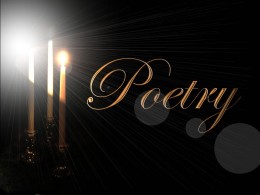
Balladeer Spotlight
(a comedic poem)
I've included this by a friend (with permission) as she included What Rhyme & Rhythm the poem adhears to
The Public Fart
It's really an art
Releasing a fart
Especially in public places.
You know you can tell
If they've caught the smell
By looks that are on people's faces.
Their noses will twitch
As if there's an itch
And their eyes may then open quite wide.
They may glance around
Or look at the ground
As they search for whatever has died.
Some may raise a hand
Pretending they'd planned
To fan at the air near their noses.
Yet others may cough
In hopes to fend off
The smell as your fart decomposes.
With watery eyes
They may then surmise
That some person has caused that bouquet.
They haven't a clue
That it was all YOU!
Simply smile as you go on your way.
--by LaDonna Olanyk
rhyme: aab
rhythm: 5-5-9
Here's another
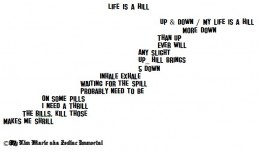
Books I've been Published in

My PUBLISHED poems
By ©Kim Marie Ostrowski
Through the Eyes of the Gods
A vast ocean of white, deep pools,
alongside hills Steep Mountains &
flat lands of snow-white cotton balls fluffy &
soft patterns of swirls or drawings
of rainbows the gods & angels make.
Sometimes the gods decide to show us their faces,
when flying about this ocean.
When below the heavenly creatures entertain us with shapes of animals
like dragons or dogs & cats, objects from everyday life &
sometimes you just might be shown Mount Olympus!
Viking Ships & Norse God Odin yelling at Loki again No doubt.
Lakes of blue pushing through
serine white paradise flight trails of angels
& canyons from the Gods' bowling.
UFO floating past flat with silver lining like a sting ray
without the tail or a stealth bomber even an eagle flying too high.
Colored painting below of green, brown red, yellow and orange,
Balls of Fire from Aries Ire.
Thor's hammer will not fall even he's enjoying the cotton ball bed.
Sitting on Guardian angels lap with my muse in the aisle
beside me a silver bullet passes
with a glint of light it passes under right from
Cloud 9 I slide down into the painting below me.
(Published by Eber & Wein)
EYEcon
Fits me, permits me
by Style & Grace
my face...
On billboards & covers of Magazines
most only dream
The Teeny boppers scream
Movies, TV & commercial streams
Blockbuster superhero
soapstar Bitch sQueenq
I've got the next Givinchy spread
Sketchers ad
Target; don't know it, but I'm
their next Brand!
Out on the town incognito Bball cap
Raybans, suntan I wouldn't pull
a Lindsay Lohan, Britney Spears
Tabloid Gossip Who Cares?!
Published by Eber & Wein
Disclaimer- ALL The poems in this section were written by me ©Kim Marie Ostrowski alone, & Published by one of the above Publishers mentioned. Any future poems published here will be in my book yet to be titled.
Storm - by Kim Marie Ostrowski
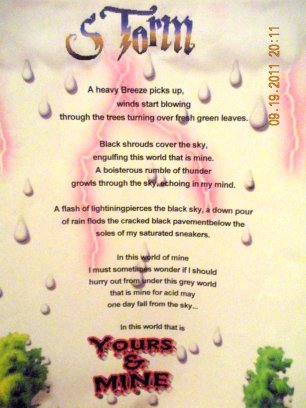
Published in The International Library of Poetry's Forever Spoken Through the Eyes of the Gods is on page 1 & Storm is in Carvings in Stone
ISBN# 1-57553-066-X page 89.
Gifts for Poets
give 1
Give 2
or fill a gift basket with all!
or a few
*a Magnetic Poetry kit (helps with inspiration)
*Book on their favorite poet's work,
*Make a Scrapbook of their poems
*a Fountain Pen (particuallarly Broad tipped)
*an old fashioned looking journal
*Rhyming Dctionary
Life without Poetry
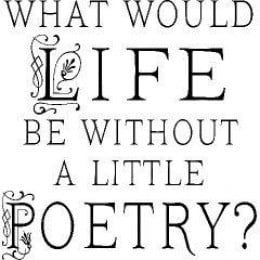
Poetry (acrostic) by Kim Marie Ostrowski
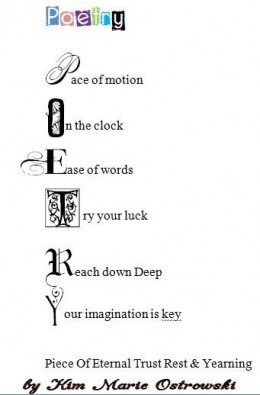
Do schools kill creativity? - from Sir Ken Robinson
What can I say to this other than my own opinion & something a customer had once told me.
To me 'School' does kill creativity at least as far as giving you a certain topic to work on or certain rules of how you may do your 'project'
Like in Poetry if the professor wants you to write a poem about yourself & say you already have an idea but he limits how you can write it & one of those pertains to your idea. What do you do then? Esp. being you already have the Inspiration/idea & personally I've found it hard to try & twist an idea in a different direction once a rule has been placed on writing it.
Same thing with creative writing..... I have a writing exercise book that yes it helps with ideas but the exercises vary, sometimes you cannot use certain words, other times you are given words you have to use in the story (which is much easier) and others letters are places in certain areas that you have to use for the next word. You are also given a starter sentence. So while it helps it is also limiting your creativity (esp. being the pages have a limited space to write on. (definitely might be better to write in a separate notebook but being its not actually class assignments I give myself some time to write each day (if that. as sometimes, even with the help of a topic & starter line.. I am still stuck to write anything.
as for that customer..Ms. Gavin (well she was a professor but I don't know of what) had once read one or 2 of my poems & told me "Do not go to school for it'
So for me a class in whatever you are already talented in, kills the creativity & quite possibly might ruin your talent as well. I only say that because you may know nothing on painting for instance but you are great at it & have even sold a couple of paintings freelance & in a gallery. You take a class to hone your skills & afterwards you don't quite have whatever it was you did before. With me it also seems that even if i love doing something, that when it comes to a 'HAVE to do' for an assignment I really no longer have interest in it for quite a long time if ever again.
I always loved reading, but while I was in school I never read recreationally, & never did again until a friend talked me into reading the Harry Potter books.
let me know your opinions
So what's your opinion? DO schools kill creativity?
Classic Journals
When I think of poetry I think of an old leather journal, with parchment or yellowed pages that the book may have been carried with its owner in the rain and all over in their travels. I also would prefer one with a lock on it at the moment as I am trying to get around to polishing up the last few poems have as drafts and printing them into the document. I do however use journals of various sizes shapes & designs to write my poems in. Sometimes they're the draft other times the journal is the master hard copy. One way or other these are nice for any writer to write poems or stories or just for an actual journal, especially for guys.
Another great idea for these are for those family & friends that do not know you write, if you write stories or poems use one of these classics to re-write them into & package it as a gift The girlfriend, wife or mom would love or ladies that your guy will love, besides some of these look pretty manly.
For an added touch if you know calligraphy or Illuminated lettering, (or are able to draw fairly well) try doing your poems that way.. Use illustrated writing (that would look especially great in these kinds of journals) or do an illustration or two for them. Maybe with in the first few pages you can draw a 'cover' for what you'd like a published book to look like.
So for those with Classic taste I give you my Top 17 choices for the best looking classic, antique, or just really cool looking leather journals.
Contests
Address, Judging process (& how is critiqued) , Dates, & Eligibility rules
This is the Contest I've been entering lately ..
Eber & Wein Publishing Contests
244 5th Avenue Suite 1900
New York New York 10001
They host 4 contests a year January 1- March 31st * April 1 - June 30 * July 1 - Sept 31 * & Then October 1st - Dec 31st
Poem Eligibility. The contest is open to ANYONE who writes poetry. The poem can be in ANY poetic style & on any subject. Entries must be 24 lines or fewer and cannot exceed 55 characters per line. (I'd like to know why we are being limited in our creativity.)
Judging process: The Entries are judged based on the Poetic Technique, effectiveness, Style & Creativity.
Critique: Those that adhere to contest rules receive a brief critique of their poem. They are included at the bottom of your author's proof.
Examples: (this is for the EYEcon poem...) The Rhythm and pitch are so strong that they intensify and concentrate the poem's effect on a level separate from the meaning of its words. For that reason, the most complete experience is reached (for the reader) when the poem is read aloud-it is enhanced by the power of the human voice"
This is the one I received for STORM - Your Poem's authenticity comes from its imagery. With Powerful, vivid imagery your poem renders a picturesque scene. Its controlling image leaves us with strong sensory impressions, placing us within your vision.
Publication- Contestants that reach the semi-finalist stage of the contest may also be selected to be featured in a poetry anthology. Even poems disqualified from the contest may be eligible for publication. (There is no purchase required & no Royalties paid to contributors.
Self publishing Your Poetry
DIY
My apologies if this section does not seem organized..It’s not. I wrote this part as I thought of what I wanted to say so I hope nothing gets anyone confused.
Keep this one thing in mind..... I'm NOT sure that if you DIY publish, that an actual publisher can take the book for publishing afterward.
(I mean esp. if you already purchase an ISBN from a website)
I have thought of making my own poetry book (as soon as I have the amount I want finished) & more or less looking through options of publishing (I want 100 poems the least for the book) Not sure if its 'legal' to self publish a book whether it be a site like authorcrossing.com or lulu.com or just printing out the pages myself & bringing them to a staples (or other place that will bind books) while you are shopping around for a real publisher.
(Plus cover art if you cannot draw might be a problem & quite expensive for one of these sites to do it for you..(But I see no OPTION to UPLOAD an image if you have drawn something of your own for your cover. (or a way to describe to them what you had in mind for cover art) Let alone if it’s a hard cover if there should be 'foil' art or a book jacket. no option for hard & or soft cover, not even a particular color you'd like it in.
Bring them to a staples or some place that will bind (suggestions.. Books of Poetry ideally should be of a 5 1/2 x8 to a 6x9 (inches) sized book ... It looks elegant, easy to hold & read from, plus quite professional looking. If (like at staples) a size like that is not available go for the large size. Be sure that if you have your poems typed on a computer (if you, like me use the fonts as a way to show your emotions & vision be sure to print your poems out yourself, because staples' etc computers will just print out the standard Times New Roman (or whatever theirs is set to) font, and you'll end up with some crazy size proportions as well!
You may want to go to authorcrossing.com you can purchase an ISBN # for your book as well as a Library of Congress Control Number $35 & US Copyright Registration $99. There are packages that can be purchased (expensive) One-Year Soft cover Channel Distribution and ISBN is $99
(& same for lulu.com but not sure if the same prices apply and Prices may have gone up since I wrote this)
see the services store tab in authorcrossing.com or lulu.com
words for Poetic
elegiac lyrical, metrical
Writing Games - prompts
Normally these would be used for prompts while creative writing, but maybe they will help for ideas.
The CREATIVE WRITING section MOVED!
YES I made a spin-off lens which some suggested as the lens was too long You can find it at:
Creative writing 101
incudes pen History
Sample outlines,
character sketches,
reports etc,
grammar brush up,
terminology and loads more
Free Verse
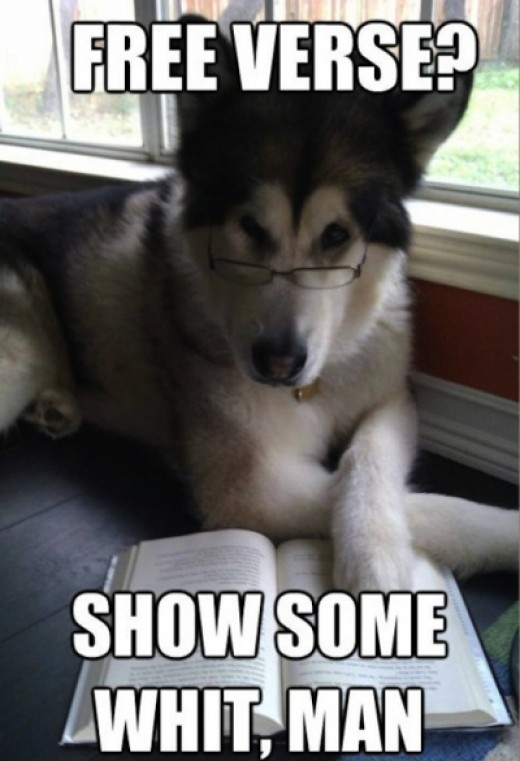
Poor man's Copyright.
I was told years ago all you had to do was mail yourself what you wanted copyrited. Not that easy. My cousin who worked for the P.O. said it has to be REGISTERED.
When you receive it DO NOT OPEN it when it comes, it must stay closed until someone claims they wrot, drew etc whatever it is.
Write Line....Poll
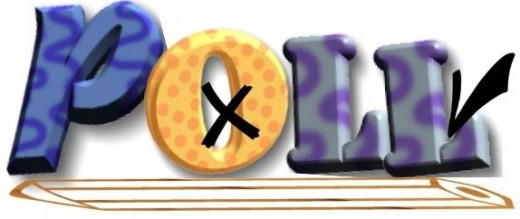
What format do you use for writing your Poems or other creative writing?
I hope I have included all the content possible if there's something you can think of that I left out please let me know and I will add the content.
If you used the page as a study guide or to learn to write a poem for a class i'd LOVE to hear how you did.
I love to hear it all. (even if I may have made a mistake I would appreciate it if you let me know so I can correct it)
One of my readers (Susan P.) contacted me & wrote this
"song lyrics to me are a way of expressing feelings. To me song lyrics, if they truly are lyrics are just that words that go together, just like a poem to tell a story or to express your feelings.
I have used music and writing songs to get through some of the most difficult times of my life. I love music, and poetry to me is so much like a song lyric, songs just have music written to express them with."
for further help See the Creative writing 101 link below and 2013 Year of the Book serieseven though it's a reading quest I have some writing stuff on it for journal prompts for writing a book review as well as a book report format/ outline and No Bummer Season Reader may have some stuff of interest as well for more help!
Visual Poetry
Antelope Canyon
